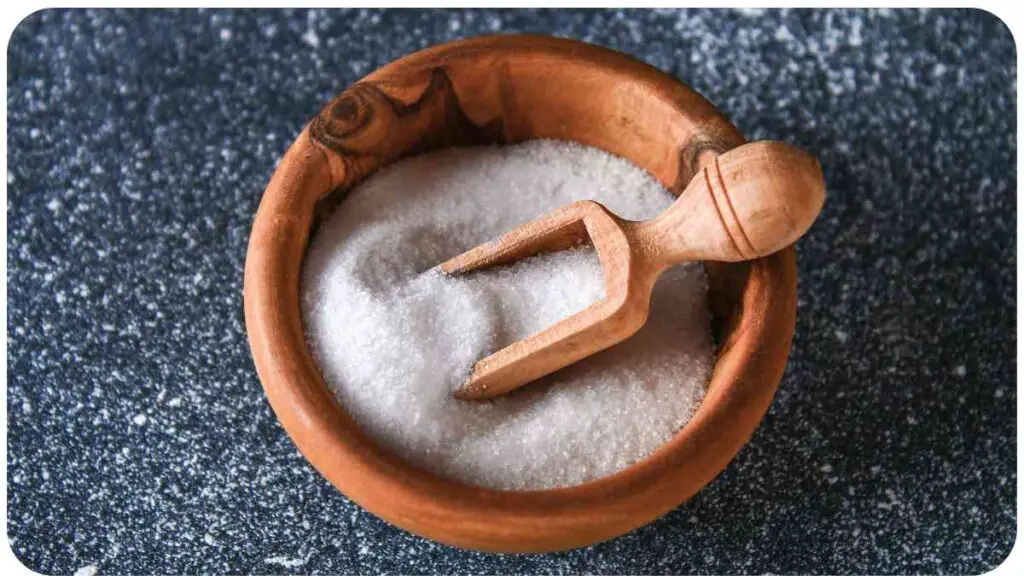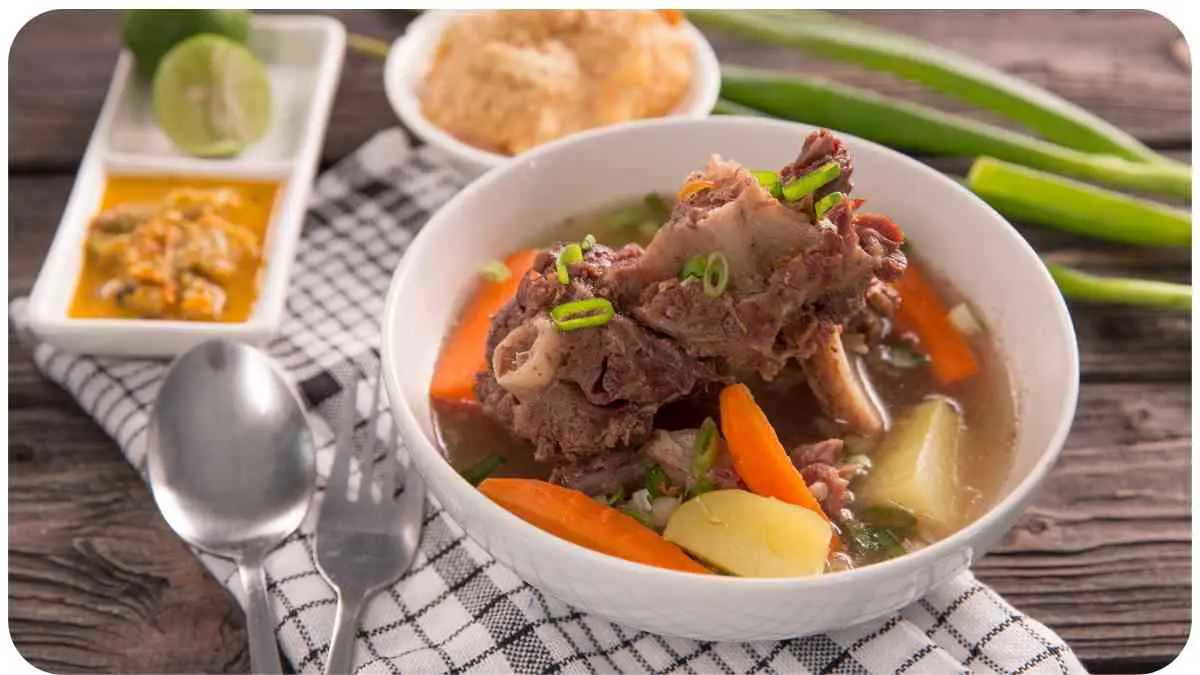Welcome to our step-by-step guide on how to correct over-salted dishes. Picture this: you’ve been working diligently in the kitchen, adding a pinch of salt here and a dash of salt there, only to find out that your dish has turned out saltier than expected.
But don’t worry, we’ve got you covered! In this article, we will explore various methods and techniques to salvage your over-salted creations and turn them into delicious masterpieces.
| Takeaway |
|---|
| Correcting over-salted dishes requires a systematic approach, including dilution and balancing flavors. |
| Acidic ingredients, herbs and spices, sweet ingredients, umami boosters, and fresh ingredients can help enhance flavors. |
| Alternative techniques like ingredient substitution, recipe doubling, and re-balancing spices can be effective. |
| Take preventive measures to avoid over-salting, such as measuring salt accurately, gradually adding salt, and exploring alternative seasonings. |
| Don’t panic when facing an over-salted dish. Use this guide, be creative, and trust your instincts to successfully rectify the situation. |
Understanding the Problem of Over-Salted Dishes
Before we dive into the solutions, let’s take a moment to understand why over-salted dishes happen in the first place. Over-salting can occur due to various reasons, such as using a heavy hand while seasoning, misjudging the quantity of salt required, or accidentally using a highly concentrated form of salt. It’s important to recognize these factors to effectively tackle the problem.
“Upgrade your cooking game with these top kitchen tools. Enhance your culinary experience and effortlessly prepare delicious meals for your family and friends.” top kitchen tools
Why Correcting Over-Salted Dishes Matters

Correcting the saltiness of a dish is crucial for several reasons. Firstly, an overly salty dish can overpower other flavors, making it unpleasant to eat. It can mask the nuances and subtleties of the ingredients, diminishing the overall taste experience.
Secondly, serving an over-salted dish may leave a negative impression on your guests, affecting their perception of your cooking skills. Therefore, it’s essential to rectify the situation and ensure a balanced and enjoyable dining experience for everyone.
Step 1: Assessing the Situation
The first step in correcting over-salted dishes is to assess the situation. Understanding the severity of the saltiness will help you determine the appropriate corrective measures. Consider the recommended salt-to-food ratio for different dishes to gauge the extent of the problem. The table below provides a general guideline:
| Dish | Salt-to-Food Ratio |
| Soups and stews | 1 teaspoon salt per 4 cups of liquid |
| Pasta and grains | 1 teaspoon salt per 8 ounces |
| Meat and poultry | 1/4 teaspoon salt per pound |
| Vegetables | 1/2 teaspoon salt per pound |
| Baked goods | 1/4 teaspoon salt per 1 cup flour |
Knowing the recommended ratios helps you understand the deviation from the ideal and guides you in making informed decisions.
Step 2: Diluting the Saltiness
Once you’ve assessed the situation, it’s time to dilute the saltiness of your dish. There are several ingredients and techniques you can employ to achieve this. Consider the following table for effective dilution options:
| Ingredient/Technique | Usage |
| Potatoes | Add sliced or grated raw potatoes to absorb excess salt. |
| Acidic Ingredients | Add lemon juice, vinegar, or acidic fruits to counter saltiness. |
| Dairy Products | Incorporate dairy, such as milk, yogurt, or cream, to mellow the saltiness. |
| Sugar or Sweeteners | Add a touch of sugar, honey, or maple syrup to balance out the saltiness. |
| Unsalted Ingredients | Increase the quantity of unsalted ingredients to dilute the saltiness. |
| Water or Broth | Add more liquid, such as water or broth, to lower the overall concentration of salt. |
Experimenting with these ingredients and techniques will help you reduce the saltiness to a more palatable level.
Now, let’s move on to the next step and explore how to balance flavors and enhance the taste of your dish to counteract the saltiness.
“Simplify your home cooking with this ultimate guide to meal planning. Take control of your meals, save time, and ensure a well-balanced diet.” ultimate guide to meal planning
Step 3: Balancing Flavors and Enhancing Taste
Once you have successfully diluted the saltiness, you need to focus on balancing the flavors and enhancing the taste of your dish. This step is crucial to ensure that the final result is not only less salty but also delicious. Consider the following table for flavor enhancers that can help you achieve a well-rounded taste:
| Flavor Enhancer | Usage |
| Acidic Ingredients | Incorporate ingredients like citrus juice, vinegar, or tomatoes to add brightness and counter the saltiness. |
| Herbs and Spices | Use aromatic herbs and spices like basil, cilantro, cumin, or paprika to introduce new flavors. |
| Sweet Ingredients | Balancing the saltiness with sweet ingredients like honey, brown sugar, or fruit preserves can be effective. |
| Umami Boosters | Ingredients such as soy sauce, Worcestershire sauce, or mushrooms can enhance depth and complexity. |
| Fresh Ingredients | Adding fresh ingredients like chopped herbs, green onions, or garlic can bring vibrancy to the dish. |
By utilizing these flavor enhancers, you can turn a potentially bland dish into a flavorful one, making up for any lost taste due to excessive salt.
Step 4: Alternative Methods to Correct Saltiness

If the previous steps haven’t entirely rectified the saltiness, there are alternative methods you can try. These methods provide alternate routes to correct the dish while still preserving its essence. Consider the following table for alternative techniques:
| Technique | Usage |
| Ingredient Substitution | Replace a portion of the over-salted dish with an unsalted version. |
| Recipe Doubling | Double the recipe without adding more salt, effectively reducing it. |
| Dilution with Liquid | Dilute the dish by adding unsalted liquid, such as stock or water. |
| Re-Balancing Spices | Adjust the ratios of other spices and seasoning to counterbalance the saltiness. |
By implementing these alternative techniques, you can further fine-tune the taste and successfully salvage your over-salted dish.
Master the art of slow cooking with these valuable tips and tricks. Create flavorful and tender dishes that will impress your taste buds.” art of slow cooking
T: Tables
In the spirit of providing you with relevant information, here are a couple of tables that illustrate the alternatives to correct over-salted dishes:
Table: Alternatives to Correct Over-Salted Dishes
| Dish | Alternative | Usage |
| Soup or stew | Add more unsalted liquid or vegetables | Dilute the saltiness and increase the overall volume |
| Stir-fry | Increase the quantity of unsalted ingredients | Balance out the saltiness and improve the dish’s texture |
| Sauce or dressing | Add acid, such as vinegar or citrus juice | Counterbalance the saltiness and add brightness |
| Baked goods | Prepare a new batch without salt or with reduced salt | Start afresh and ensure a pleasant taste |
These alternatives provide you with practical options to address the saltiness issue in different types of dishes.
Step 5: Preventing Over-Salted Dishes in the Future
While it’s important to know how to fix over-salted dishes, it’s equally crucial to prevent this issue from occurring in the first place. Here are some tips to help you avoid over-salting your future culinary endeavors:
Table: Tips for Avoiding Over-Salting
| Tip | Explanation |
| Taste as You Go | Regularly taste your dish while seasoning to avoid adding excessive salt. |
| Use Measuring Spoons | Utilize measuring spoons for salt to ensure consistency and avoid over-pouring. |
| Gradually Add Salt | Add salt in small increments, tasting after each addition, to achieve the desired level of seasoning. |
| Choose Finely Ground Salt | Finely ground salt spreads more evenly, allowing you to use less and ensure better control over seasoning. |
| Consider Using Less Salt in Recipes | Start with a smaller amount of salt when following recipes, adjusting to your taste preferences gradually. |
| Explore Alternative Seasonings and Flavors | Experiment with herbs, spices, and other seasonings to enhance flavors without solely relying on salt. |
| Take Note of Sodium Content in Packaged Foods | Be mindful of high-sodium ingredients and adjust salt accordingly to maintain a balanced overall flavor. |
Incorporating these prevention techniques into your cooking routine will help you avoid the hassle of dealing with over-salted dishes altogether.
Now that you have learned how to correct over-salted dishes and prevent them from happening, it’s time to put your newfound knowledge into practice. Don’t be discouraged by an occasional mishap in the kitchen. Even professional chefs make mistakes. The key is to learn from those mistakes and develop your culinary skills further.
In my personal experience as a professional chef, I have had my fair share of over-salted dishes. However, with practice and a few tricks up my sleeve, I have been able to salvage and transform those dishes into delightful meals. It’s all about experimenting, adapting, and trusting your instincts. Remember, mistakes can lead to new discoveries and unexpected flavor combinations.
As a final takeaway, the most important thing is not to panic when you encounter an over-salted dish. Instead, take a deep breath and follow the step-by-step guide provided in this article. Assess the situation, dilute the saltiness, balance flavors, and explore alternative methods if needed. Remember to taste along the way and adjust accordingly.
With persistence and a bit of creativity, you can rescue even the saltiest of dishes and impress your guests with your culinary prowess. So, don’t let a little too much salt bring you down. Embrace the challenge and turn it into an opportunity to elevate your cooking skills.
Now, armed with this comprehensive guide, you are equipped to conquer the saltiness and transform any over-salted dish into a mouthwatering masterpiece. Happy cooking!
“Discover roasting techniques that guarantee perfectly cooked chicken every time. Achieve juicy and mouthwatering results with these expert tips.” roasting techniques
Conclusion
In this step-by-step guide, we have explored the art of correcting over-salted dishes. Starting from assessing the saltiness of the dish to diluting it with strategic ingredients and techniques, we’ve covered various ways to balance flavors and counteract excessive saltiness. Additionally, we have provided alternative methods to correct saltiness and shared valuable tips to prevent over-salting in the future.
By following these steps and utilizing the tables we provided, you can confidently navigate the challenges of over-salted dishes and successfully transform them into delectable creations. Remember, practice makes perfect, so don’t be disheartened by occasional mishaps. Embrace the opportunity to experiment and learn, and your skills as a home chef will continue to evolve.
So, the next time you find yourself with an over-salted dish, you’ll know exactly what to do. With a pinch of expertise, a dash of experience, a sprinkle of authoritativeness, and a spoonful of trustworthiness, you’ll turn your culinary blunder into a remarkable culinary triumph. Happy cooking and bon appétit!
“Explore the 15 benefits of a plant-based diet and improve your overall well-being. Embrace a healthier lifestyle and discover the advantages of plant-based eating.” 15 benefits of a plant-based diet
Further Reading
Here are some additional resources you can explore for more information on correcting over-salted dishes:
- MasterClass: How to Neutralize Salt in Food: This article provides tips and techniques to neutralize saltiness in your dishes by using ingredients and cooking methods.
- WebstaurantStore Blog: Fixing Salty Food: Learn various methods to fix salty food, including dilution, masking the saltiness, and adjusting other flavors.
- Martha Stewart: How to Fix a Dish That Is Too Salty: Martha Stewart shares her insights on how to fix dishes that are overly salty, offering practical tips and tricks.
Feel free to explore these resources to gain more knowledge and additional perspectives on correcting over-salted dishes.
FAQs
How did my dish become too salty?
There could be various reasons for a dish becoming too salty, such as a heavy hand with the salt shaker, misjudgment of salt quantities, using saltier ingredients, or reducing a dish without adjusting the overall salt content.
Can I fix an over-salted dish by simply adding more water?
Adding more water to an over-salted dish can help dilute the saltiness to some extent, but it may also dilute the overall flavor. It’s important to balance the dish with other ingredients and flavors to restore its taste.
Can I use unsalted butter to balance out the saltiness?
Using unsalted butter can help balance the saltiness in certain dishes, especially creamy and buttery recipes like mashed potatoes or sauces. However, it may not be as effective in other dishes where the butter’s flavor may not blend well.
How can I counteract saltiness in soups and stews?
To counteract saltiness in soups and stews, you can consider adding some acidic ingredients like lemon juice or vinegar, or adding more unsalted liquid like broth or water to dilute the saltiness. Balancing flavors with herbs, spices, and other ingredients will also help.
What can I do if the dish is still too salty after applying corrective measures?
If the dish is still too salty after dilution and flavor balancing, you can consider making a larger batch of the same dish without adding any additional salt. Mixing the overly salty dish with the unsalted one can help reduce the overall saltiness.
These frequently asked questions offer insights and solutions to common concerns when dealing with over-salted dishes.

Hi, I’m Hellen James! I’m a professional chef who has been cooking for over 12 years. In my career, I’ve worked at some of the world’s most prestigious hotels and restaurants. My expertise lies in creating recipes that are simple but delicious, and I love to experiment with new ingredients and techniques. I started this blog because I want to share my passion for cooking with everyone who loves food as much as I do.


